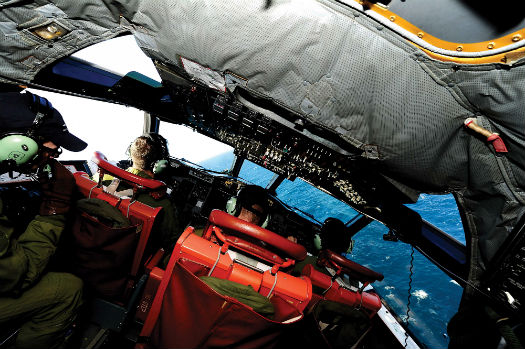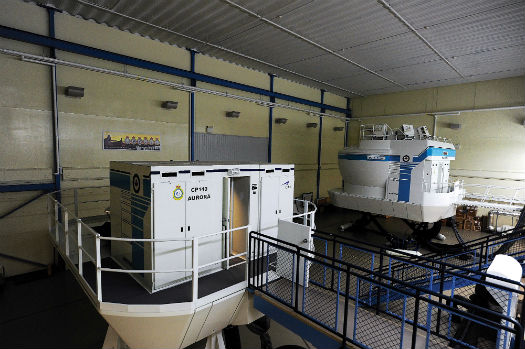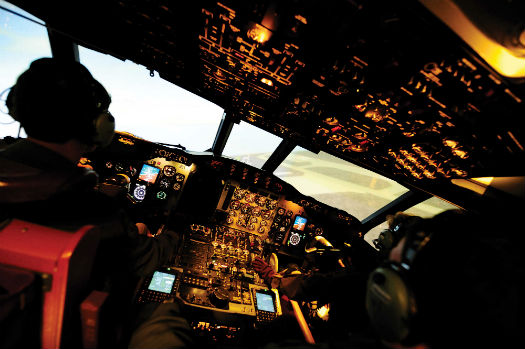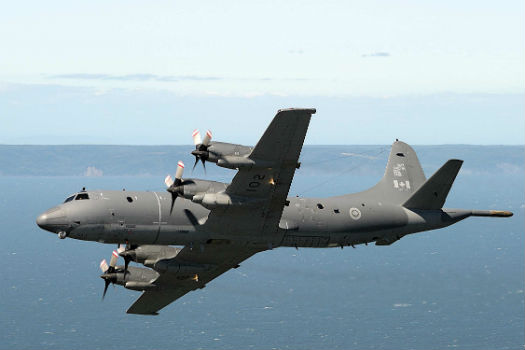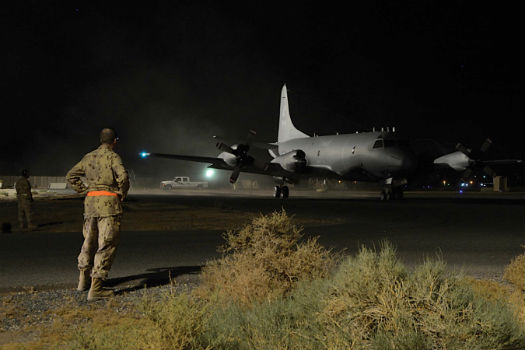The improved capabilities of the Block III CP-140M Aurora were demonstrated in May 2014, when RCAF crews participated in a multinational NATO interoperability trial in Orland, Norway. During a simulated crisis scenario, Canadian crews gathered invaluable data for mission commanders, while showcasing the Aurora’s expanded abilities.
Intelligence, surveillance and reconnaissance (ISR) is the tactical trio that has long underpinned any military deployment, even before the development of aircraft.
Nowadays, that most fundamental of roles falls to the men and women who crew the Royal Canadian Air Force (RCAF) fleet of modernized Lockheed Martin CP-140 Auroras. Two of those aircraft are currently deployed to the Middle East as part of Operation Impact, Canada’s contribution to the multinational effort against the Islamic State of Iraq and the Levant (ISIL)—a militant group that is plundering and terrorizing northern Iraq and threatening Turkey, a North Atlantic Treaty Organization (NATO) ally.
Together with six Boeing CF-18 Hornet fighters, deployed from 409 Tactical Fighter Squadron at 4 Wing in Cold Lake, Alta., and an Airbus CC-150 Polaris tanker from 437 Transport Squadron at 8 Wing in Trenton, Ont., the CP-140s deployed to a desert airbase in Kuwait in late October. Little more than a week later, two Hornet pilots completed their first combat mission, a four-hour sortie supported by the Polaris, in which they launched GBU-12 500-pound laser-guided Paveway II munitions against ISIL targets near Fallujah, some 70 kilometres west of Baghdad.
The underlying key to the mission’s success was information gathered by the crews of the Auroras, an aircraft which entered service with the RCAF in 1980 as a replacement for the Canadair CP-107 Argus. The four-engined turboprops were the most advanced long-range patrol and anti-submarine warfare platform of the day. Thanks to extensive upgrades, the remaining fleet is still the backbone of the RCAF’s ISR capability and is expected to remain in service until at least 2030, with their crews repeatedly proving their mettle at home and abroad.
A variant of the Lockheed P-3 Orion developed in the 1960s for the United States Navy—itself a derivative of the short-lived L-188 Electra airliner—but fitted from the outset with different missions systems, the CP-140 has been upgraded by IMP Aerospace in Halifax, N.S., a few minutes away by air from the Auroras’ home base at 405 Long Range Patrol Squadron at 14 Wing Greenwood, N.S.
In September 2014, CAE was awarded a contract to upgrade the visual systems on the CP-140 full flight simulator (right). The RCAF has been placing a greater emphasis on simulated training, including through the use of a more basic cockpit procedures trainer (left).
That’s where Defence Minister Rob Nicholson was on hand for the Oct. 24, 2014, departure of the two Auroras for Kuwait.
“The operation includes approximately 600 personnel, including [69 special operations] members already working with Americans in an advisory and assistance role, providing strategic and tactical advice to Iraqi security forces and aircrew support elements, such as command and control and logistics,” said Nicholson. “The deploying Canadian Armed Forces members will enhance Canada’s mission in the Middle East and will provide strategic and tactical support to Iraqi forces.”
Meanwhile, at home, Aurora crews continue domestic surveillance missions along Canada’s three coastlines and offshore regions, as well as deploying air-droppable survival pods as part of their search and rescue work. The minimum crew on a routine mission is 10, but that is bumped up as complexity increases. A typical crew would comprise the aircraft commander, a co-pilot, flight engineer, tactical navigator, a navigation/communications operator, three airborne electronic sensor operators (AESOPs) and two acoustic sensor operators. As range and mission time are extended, to 12 hours or more, an additional pilot and AESOP are added.
West Coast operations are handled by 407 Long Range Patrol Squadron, part of 19 Wing in Comox, B.C., on the east coast of Vancouver Island. They also support other government departments and agencies in combating illegal immigration, fishing, polluting and drug trafficking, as well as supporting disaster relief efforts.
The Auroras’ dependability and state-of-the-art ISR capabilities have been used to good effect in various international missions.
High-profile Ops
Outside of routine patrols or classified missions, the Auroras have had a globally-acknowledged role in some high-profile operations, such as Operation Sharp Guard, the 1992-1995 NATO-led blockade of the former Yugoslavia, and Operation Apollo in the Persian Gulf from late 2001 to mid-2003, flying 500 patrols in the international campaign against terrorism. In 2011, Auroras flew 181 sorties in support of Operation Mobile, with two aircraft and two crews deployable on short notice, helping to enforce a no-fly zone over Libya, and providing critical ISR data to U.S., British and French forces operating under a United Nations mandate. Thanks to modernization and an aggressive maintenance schedule, only one mission had to be scrubbed, and that was because of a bird strike rather than any mechanical issues.
Similarly, for the last four years, the Auroras’ dependability and state-of-the-art ISR capabilities have been used to good effect in Operation Caribbe, a multinational campaign which began in 2006, a U.S.-led attempt to cut organized crime’s drug supply lines in the Caribbean basin, the Gulf of Mexico and the eastern Pacific Ocean. It was expanded in 2010 with a Memorandum of Understanding between the Department of National Defence and the U.S. Department of Homeland Security, enabling U.S. Coast Guard personnel to operate from Royal Canadian Navy vessels.
An Aurora was a critical element of Operation Assistance for flood-ravaged southern Manitoba in 1997; flying at night, the crew used the aircraft’s L-3 Wescam MX-20 electro-optical and infra-red camera turret and overland mission system to assess the situation on the ground every 30 minutes, enabling engineers to deal with issues as they developed. That mission was repeated last summer, when the rising Assiniboine River prompted the provincial government to declare another state of emergency. Auroras also supported the Royal Canadian Mounted Police presence at the 2010 Winter Olympics in and around Vancouver, and the G-8 and G-10 Summits that year in Ontario.
Long trained in anti-submarine warfare (ASW), modern Aurora crews are learning new skills, including intelligence-gathering over land.
Maintaining and Modernizing
With more than a half century of in-service support (ISS) for a number of RCAF platforms, IMP is one of only two Lockheed Martin authorized service centres for the Aurora; the other being Down Under, handling the Royal Australian Air Force fleet of 18 AP-3C-Orions.
Having supported the Aurora since 1984, IMP delivered its 100th CP-140 Aurora Third Level Inspection and Repair Program (TLIR) aircraft to the RCAF in September 2014.
“Through these years, IMP has developed significant knowledge and experience on maintaining and modernizing the aircraft to meet the operational requirements of the RCAF,” Tom Galley, IMP Aerospace’s executive vice president said at the handover ceremony. “We are proud of this milestone achievement . . . and look forward to continuing our support to this strategic asset throughout its entire life cycle.”
The modernization plan involved three blocks of work to replace aircraft systems which could no longer be supported; conversion to a glass cockpit; and then installation of a new mission computer and sensors.
IMP was the prime contractor on Block 1, which essentially standardized the fleet configuration. “Every aircraft over a period of time developed a certain amount of customization, with modifications performed on some aircraft and not on others,” explained Galley. That included the CP-140A Arcturus version, which Canada snapped up when Lockheed Martin shut down P-3 production in Burbank, Calif., in 1991. They were not fitted with ASW gear, and DND used them mostly for pilot training as well as for northern and coastal patrols before retiring them to desert storage in the U.S.
While Thales and CMC were the Block 2 prime contractors, IMP performed all the installation design, wiring harness production, the installation itself, and flight testing to ensure systems compatibility, as well as liaising with DND alongside the two primes.
Block 3, the key to a half-century operational life, began in 1998 as the Aurora Incremental Modernization Project (AIMP), but that was halted by the Department of National Defence in September 2007 while it evaluated whether the upgrade should continue or the fleet should be replaced. DND rescinded the stop order three months later, setting the stage for an array of upgraded systems, essentially standardizing to a common platform in a fleet where there had been some customization to “keep the aircraft safe and operationally viable” until at least 2020.
This last block, a total upgrade of the aircraft’s sensors, data gathering and tactical information display, has been primed by General Dynamics Canada (GDC), which subcontracted to Texas-based L-3 Integrated Systems the prototyping and proof-fitting of two aircraft fitted with GDC’s new mission system, including computers, acoustics, radar and forward-looking infrared capability.
Once the prototypes had been flown to Greenwood, IMP was manufacturing and installing the production upgrade kits. But DND, looking to streamline programs, eventually tasked IMP with merging the electronics modifications in Block 3 into its parallel Aurora Structural Life Extension Project (ASLEP) work on the wings and stabilizers.
Canada announced in March 2014 that it would expand its fleet of upgraded CP-140M Auroras from 10 aircraft to 14 in order to meet requirements.
Manufactured in Marietta, Ga., the ASLEP kit evolved from a C-130 Hercules project Lockheed Martin did for U.S. operators after a number of C-130s had suffered catastrophic wing failures, eventually attributed to wing-box fatigue. When the U.S. Navy was flying hundreds of P-3s a decade ago, Lockheed finalized a structural life assessment and determined that a significant number were at or quickly approaching the end of their useful fatigue life. Since the last P-3 had been built in 1991, Lockheed Martin had to build new tooling to produce upgraded wings, using modern alloys and sealants to improve fundamental integrity and corrosion resistance.
By replacing the outer wings, the lower section of the centre wing and the horizontal stabilizers, the ASLEP is expected to add 15,000 hours to each airframe’s life. All structures with specific fatigue lives are being replaced with enhanced-design components and improved corrosion-resistant materials, which are expected to reduce maintenance costs going forward.
Started earlier this year and scheduled for completion by 2021, the ASLEP and an Aurora Extension Proposal (AEP) represent a $2 billion government investment designed to extend the fleet’s operational effectiveness by an additional decade.
While many air and naval forces are replacing their P-3 Orions with Boeing P-8 Poseidons, a design based on the 737-800ERX commercial jet, Canada has opted to upgrade its Auroras, even as DND planners continue looking at options for beyond 2030. Purchasing new aircraft would be a hugely expensive undertaking at a time of increasingly tight DND budgets; so, for the time being at least, Canada has taken the position that the best Aurora replacement is an updated Aurora.
Canadian Armed Forces aircrew members wait for the arrival of the CP-140M Aurora in Kuwait, in support of Operation Impact on Oct. 29, 2014. DND Photo
New Mission Set
LCol Mike Adamson, now executive assistant to the vice-chief of the defence staff, LGen Guy Thibault, was 405 Squadron’s commanding officer during a Skies visit to Greenwood in 2013.
“The sky’s the limit,” he said at the time, referring to the reborn Aurora. “It’s not just the equipment suite. It’s new missions that come with it. We need to ensure that we fight the aircraft as efficiently as possible.”
A self-described “air force brat” whose father flew Lockheed CF-104 Starfighters, Adamson said the Aurora’s new sensors “are so much more capable” and the electronic support measures (ESM) are “well beyond anything we’ve got at the moment.” This has enabled the Aurora crews to assist other elements of the Canadian Armed Forces, including Special Operations Command and the fighter community.
“We can stand off X number of miles and get imagery of your target,” Adamson said of Aurora’s ISR role. “We can sit over top at 25,000 feet and give them what’s around the corner. There’s been a very strong . . . campaign of ‘this is what we can do for you now’ and . . . we’re generating appetite.”
Compared with when he first flew the Aurora in 1995, Adamson said the upgraded platform is “a huge change” for the RCAF. In the past, the Aurora was almost exclusively a navy asset for ASW missions. With the abrupt thaw in the Cold War, things changed.
“It’s not the same mission set; we’re not out hunting submarines as frequently as we used to, but it’s a skill set that must be maintained. . . . If you can do ASW, you can do anything. The choreography required in the aircraft, all the different sensors and the people working in the airplane to deliver a single effect—if you can coordinate that, you can do pretty much anything,” said Adamson.
Also, other than transiting out on a maritime mission, Aurora crews didn’t fly many overland missions. Now, these account for half of their work, as they use their sensors to track people and vehicles, including through tree cover with their L-3 Wescam infrared capabilities.
“It’s certainly got a new lease on life which would be a concern if we weren’t changing out the structural components as well,” said Adamson, who is not worried about the aircraft “ageing out” from a maintenance or safety viewpoint. “It’s probably more relevant now that it was 20 years ago. It was state-of-the-art when it first came on; we enjoyed that for a little while, and then other nations played catch up. Now, we’re back to being in the lead.”
